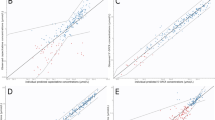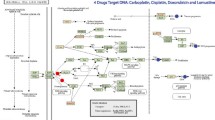Abstract
Cyclophosphamide (CP) is widely used in high-dose chemotherapy regimens in combination with thioTEPA. CP is a prodrug and is activated by cytochrome P450 to 4-hydroxycyclophosphamide (HCP) which yields the final cytotoxic metabolite phosphoramide mustard (PM). The metabolism of CP into HCP exhibits autoinduction but is inhibited by thioTEPA. The aim of this study was to develop a population pharmacokinetic model for the bioactivation route of CP incorporating the phenomena of both autoinduction and the drug–drug interaction between CP and thioTEPA. Plasma samples were collected from 34 patients who received high-dose CP, thioTEPA and carboplatin in short infusions during 4 consecutive days. Elimination of CP was described by a noninducible route and an inducible route leading to HCP. The latter route was mediated by a hypothetical amount of enzyme. Autoinduction leads to a zero-order increase in amount of this enzyme during treatment. Inhibition by thioTEPA was modeled as a reversible, competitive, concentration-dependent inhibition. PM pharmacokinetics were described by first-order formation from HCP and first-order elimination. The final models for CP, HCP, and PM provided an adequate fit of the experimental data. The volume of distribution, noninducible and initial inducible clearances of CP were 31.0 L, 1.58 L/hr and 4.76 L/hr, respectively. The enzyme amount increased with a zero-order rate constant of 0.041 amount * hr−1. After each thioTEPA infusion, however, approximately 80% of the enzyme was inhibited. This inhibition was reversible with a half-life of 6.5 hr. The formation and elimination rate constants of PM were 1.58 and 0.338 hr−1, respectively. The developed model enabled the assessment of the complex pharmacokinetics of CP in combination with thioTEPA. This model provided an adequate description of enzyme induction and inhibition and can be used for treatment optimization in this combination.
Similar content being viewed by others
REFERENCES
E. van der Wall, J. H. Beijnen, and S. Rodenhuis. High-dose chemotherapy for solid tumors. Cancer Treat. Rev." 21:105–132 (1995).
T. K. H. Chang, L. Yu, J. A. Goldstein, and D. J. Waxman. Identification of the polymorphically expressed CYP2C19 and the wild-type CYP2C9-ILE 359 allele as low-Km catalysts of cyclophosphamide and ifosfamide activation. Pharmacogenetics 7:211–221 (1997).
T. K. H. Chang, G. F. Weber, C. L. Crespi, and D. J. Waxman. Differential activation of cyclophosphamide and ifosphamide by cytochromes P–450 2B and 3A in human liver microsomes. Cancer Res. 53:5629–5637 (1993).
S. Ren, J. S. Yang, T. F. Kalhorn, and J. T. Slattery. Oxidation of cyclophosphamide to 4-hydroxycyclophosphamide and deschloroethylcyclophosphamide in human liver micro-somes. Cancer Res. 57:4229–4235 (1997).
P. Roy, L. J. Yu, C. L. Crespi, and D. J. Waxman. Development of a substrate-activity based approach to identify the major human liver P–450 catalysts of cyclophosphamide and ifosfamide activation based on cDNA-expressed activities and liver microsomal P–450 profiles. Drug Metab. Dispos. 27:655–666 (1999).
S. Ren, T. F. Kalhorn, G. B. McDonald, C. Anasetti, F. R. Appelbaum, and J. T. Slattery. Pharmacokinetics of cyclophosphamide and its metabolites in bone marrow transplan-tation patients. Clin. Pharmacol. Ther. 64:289–301 (1998).
D. Busse, F. W. Busch, E. Schweizer, F. Bohnenstengel, M. Eichelbaum, P. Fischer, K. Schumacher, W. E. Aulitzky, and H. K. Kroemer. Fractionated administration of high-dose cyclophosphamide: influence on dose-dependent changes in pharmacokinetics and metabolism. Cancer Chemother. Pharmacol. 43:263–268 (1999).
G. Fasola, P. LoGreco, E. Calori, M. Zilli, F. Verlicchi, M. R. Motta, P. Ricci, M. Baccar-ani, and S. Tura. Pharmacokinetics of high-dose cyclophosphamide for bone marrow transplantation. Haemotologica 76:120–125 (1991).
T. L. Chen, J. L. Passos-Coelho, D. A. Noe, J. Kennedy, K. C. Black, O. M. Colvin, and L. B. Grochow. Nonlinear pharmacokinetics of cyclophosphamide in patients with metastatic breast cancer receiving high-dose chemotherapy followed by autologous bone marrow transplantation. Cancer Res . 55:810–816 (1995).
M. J. Moore, R. W. Hardy, J. J. Thiessen, S. J. Soldin, and C. Erlichman. Rapid develop-ment of enhanced clearance after high-dose cyclophosphamide. Clin. Pharmacol. Ther. 44:622–628 (1988).
U. Schuler, P. Waidelich, H. Kolb, T. Wagner, and G. Ehninger. Pharmacokinetics and metabolism of cyclophosphamide administered after total body irradiation of bone marrow transplant recipients. Eur. J. Clin. Pharmacol. 40:521–523 (1991).
R. J. Motzer, S. C. Gulati, W. P. Tong, C. Menendez-Botet, P. Lyn, M. Mazumdar, V. Vlamis, S. Lin, and G. J. Bosl. Phase I trial with pharmacokinetic analyses of high-dose carboplatin, etoposide, and cyclophosphamide with autologous bone marrow transplan-tation in patients with refractory germ cell tumors. Cancer Res. 53:3730–3735 (1993).
Y. Nieto, X. Xu, P. J. Cagnoni, S. Matthes, E. J. Shpall, S. I. Bearman, J. Murphy, and R. B. Jones. Nonpredictable pharmacokinetic behavior of high-dose cyclophosphamide in combination with cisplatin and 1,3-bis(2-chloroethyl)–1-nitrosurea. Clin. Cancer Res. 5:747–751 (1999).
U. Schuler, G. Ehninger, and T. Wagner. Repeated high-dose cyclophosphamide adminis-tration in bone marrow transplantation: exposure to activated metabolites. Cancer Chemother. Pharmacol. 20:248–252 (1987).
M. J. van Maanen, C. J. M. Smeets, and J. H. Beijnen. Chemistry, pharmacology and pharmacokinetics of N,N′,N″-triethylenethiophosphoramide (thioTEPA). Cancer Treat. Rev. 26:257–268 (2000).
M. J. van Maanen, I. M. Tijhof, M. A. Damen, C. Versluis, J. J. Kettenes-van den Bosch, A. J. R. Heck, S. Rodenhuis, and J. H. Beijnen. A search for new metabolites of thioTEPA. Cancer Res. 59:4720–4724 (1999).
A. D. R. Huitema, T. Kerbusch, M. M. Tibben, S. Rodenhuis, and J. H. Beijnen. Reduction of cyclophosphamide bioactivation by thioTEPA: Critical sequence-dependency in high-dose chemotherapy regimens. Cancer Chemother. Pharmacol. 46:119–127 (2000).
L. W. Anderson, T. L. Chen, O. M. Colvin, L. B. Grochow, J. M. Collins, M. J. Kennedy, and J. M. Strong. Cyclophosphamide and 4-hydroxycyclophosphamide_aldophosphamide kinetics in patients receiving high-dose cyclophosphamide chemotherapy. Clin. Cancer Res. 2:1481–1487 (1996).
S. Rodenhuis, A. Westermann, M. J. Holtkamp, W. J. Nooijen, J. W. Baars, E. van der Wall, I. C. M. Slaper-Cortenbach, and J. H. Schornagel. Feasibility of multiple courses of high-dose cyclophosphamide, thioTEPA, and carboplatin for breast cancer or germ cell cancer. J. Clin. Oncol. 14:1473–1483 (1996).
S. Rodenhuis, D. J. Richel, W. van der Wall, J. H. Schornagel, J. W. Baars, C. C. E. Koning, J. L. Peterse, J. H. Borger, W. J. Nooijen, R. Bakx, O. Dalesio, and E. Rutgers. Randomized trial of high-dose chemotherapy and haemopoeitic progenitor-cell support in operable breast cancer with extensive auxillary lymph-node involvement. Lancet 352:515–521 (1998).
S. Rodenhuis, J. W. Baars, J. H. Schornagel, L. T. Vlasveld, I. Mandjes, H. M. Pinedo, and D. J. Richel. Feasibility and toxicity study of a high-dose chemotherapy regimen for autotransplantation incorporating carboplatin, cyclophosphamide and thioTEPA. Ann. Oncol. 3:855–860 (1992).
A. D. R. Huitema, M. Holtkamp, M. M. Tibben, S. Rodenhuis, and J. H. Beijnen. Sam-pling technique from central venous catheters proves critical for pharmacokinetic studies. Ther. Drug Monit. 21:102–104 (1999).
A. D. R. Huitema, M. M. Tibben, T. Kerbusch, J. W. Zwikker, S. Rodenhuis, and J. H. Beijnen. Simultaneous determination of N,N′,N″-triethylenethiophosphoramide, cyclopho-sphamide and some of their metabolites using capillary gas chromatography. J. Chromatogr. B 716:177–186 (1998).
A. D. R. Huitema, M. M. Tibben, T. Kerbusch, J. J. Kettenes-van den Bosch, S. Roden-huis, and J. H. Beijnen. High performance liquid chromatographic determination of the stabilized cyclophosphamide metabolite 4-hydroxycyclophosphamide in plasma and red blood cells. J. Liq. Chromatogr. Rel. Tech. 23:1725–1744 (2000).
A. D. R. Huitema, M. M. Tibben, T. Kerbusch, J. J. Kettenes-van den Bosch, S. Roden-huis, and J. H. Beijnen. Simple and selective determination of the active cyclophosphamide metabolite phosphoramide mustard in human plasma using high-performance liquid chromatography. J. Chromatogr. B 745:345–355 (2000).
S. L. Beal, and L. B. Sheiner. NONMEM User's Guides., NONMEM Project Group, University of California at San Francisco, San Francisco (1998).
M. Hassan, U. S. H. Svensson, P. Ljungman, B. Bjö rkstrand, H. Olsson, M. Bielenstein, M. Abdel-Rehim, C. Nilsson, M. Johansson, and M. O. Karlsson. A mechanism-based pharmacokinetic-enzyme model for cyclophosphamide autoinduction in breast cancer patients. Br. J. Clin. Pharmacol. 48:669–677 (1999).
T. Kerbusch, A. D. R. Huitema, J. Ouwerkerk, H. J. Keizer, R. A. A. Mathĉ t, J. H. M. Schellens, and J. H. Beijnen. Evaluation of the autoinduction of ifosfamide metabolism by a population pharmacokinetic approach using NONMEM. Br. J. Clin. Pharmacol. 49:555–561 (2000).
E. N. Johnsson and M. O. Karlsson. Xpose—an S-PLUS based population pharmacoki-netic– pharmacodynamic model building aid for NONMEM. Comput. Meth. Prog. Biomed. 58:51–64 (1998).
U.S. Department of Health and Human Services, Food and Drug Administration. Guid-ance for industry: Population Pharmacokinetics. Rockville, MD, (1999).
J. H. Lin, and A. Y. H. Lu. Inhibition and induction of cytochrome P450 and the clinical implications. Clin. Pharmacokinet. 35:361–390 (1998).
P. Azagra, J. J. Pérez, V. Alberola, C. Medina, N. V. Jiménez, and J. Garcia-Conde. Population-pharmacokinetics (PK) study of high-dose cyclophosphamide (CPP) in a pro-gram of high dose chemotherapy (HDCT) and peripheral blood stem cell (PBSC) trans-plantation in high risk (HR) breast cancer (BC) patients (PTS). Proc. Am. Soc. Clin. Oncol. 17:81 (1998).
A. V. Boddy, M. Cole, A. D. J. Pearson, and J. R. Idle. The kinetics of the auto-induction of ifosfamide metabolism during continuous infusion. Cancer Chemother. Pharmacol. 36:53–60 (1995).
T. K. H. Chang, L. Yu, P. Maurel, and D. J. Waxman. Enhanced cyclophosphamide and ifosfamide activation in primary human hepatocyte cultures: Response to cytochrome P– 450 inducers and autoinduction by oxaxaphosphorines. Cancer Res. 57:1946–1954 (1997).
T. B. Kudriakova, L. A. Sirota, G. I. Rozova, and V. A. Gorkov. Autoinduction and steady-state pharmacokinetics of carbamazepine and its major metabolites. Br. J. Clin. Pharmacol. 33:611–615 (1992).
R. D. Scheyer, J. A. Cramer, and R. H. Mattson. A pharmacodynamic approach to the estimate of carbamazepine autoinduction. J. Pharm. Sci. 4:491–494 (1994).
C. von Bahr, E. Steiner, Y. Koike, and J. Gabrielsson. Time course of enzyme induction in humans: Effect of pentobarbital on nortriptyline metabolism. Clin. Pharmacol. Ther. 64:18–26 (1998).
H. Takanaga, A. Ohnishi, H. Matsuo, H. Murakami, H. Sata, K. Kuroda, A. Urae, S. Higuchi, and Y. Sawada. Pharmacokinetic analysis of felodipine–grapefruit juice interac-tion based on an irreversible enzyme inhibition. Br. J. Clin. Pharmacol. 49:49–58 (2000).
H. Takanaga, A. Ohnishi, H. Murakami, H. Matsuo, S. Higuchi, A. Urae, S. Irie, H. Furuie, K. Matsukuma, M. Kimura, K. Kawano, Y. Orii, T. Tanaka, and Y. Sawada. Relationship between time after intake of grapefruit juice and the effect on pharmacokinet-ics and pharmacodynamics of nisoldipine in healthy subjects. Clin. Pharmacol. Ther. 67:201–214 (2000).
D. Busse, F. W. Busch, F. Bohnenstengel, M. Eichelbaum, P. Fischer, J. Opalinska, K. Schumacher, E. Schweizer, and H. K. Kroemer. Dose escalation of cyclophosphamide in patients with breast cancer: Consequences for pharmacokinetics and metabolism. J. Clin. Oncol. 15:1885–1896 (1997).
Rights and permissions
About this article
Cite this article
Huitema, A.D.R., Mathôt, R.A.A., Tibben, M.M. et al. A Mechanism-Based Pharmacokinetic Model for the Cytochrome P450 Drug–Drug Interaction between Cyclophosphamide and ThioTEPA and the Autoinduction of Cyclophosphamide. J Pharmacokinet Pharmacodyn 28, 211–230 (2001). https://doi.org/10.1023/A:1011543508731
Issue Date:
DOI: https://doi.org/10.1023/A:1011543508731




